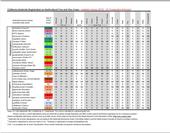- Re-posted by: Gale Perez
- Posted by: Zheljana Peric | WeedsNews
Abstract: Agricultural weed management has become entrenched in a single tactic—herbicide—resistant crops—and needs greater emphasis on integrated practices that are sustainable over the long term. In response to the outbreak of glyphosate-resistant weeds, the seed and agrichemical industries are developing crops that are genetically modified to have combined resistance to glyphosate and synthetic auxin herbicides. This technology will allow these herbicides to be used over vastly expanded areas and will likely create three interrelated challenges for sustainable weed management. First, crops with stacked herbicide resistance are likely to increase the severity of resistant weeds. Second, these crops will facilitate a...
- Posted By: Brad Hanson
- Written by: WSSA press release
Reposted from a recent WSSA press release on herbicide resistant weeds by the Weed Science Society of America.
Brad
Today the Weed Science Society of America (WSSA) announced it will co-sponsor an upcoming scientific summit on how to manage herbicide-resistant weeds — a costly and growing problem threatening crop production across the U.S. and around the globe.
The May 10 event is being organized by the National Research Council, the operating arm of the National Academy of Sciences, and will be held at George Washington University in Washington, D.C.
Several WSSA members will deliver presentations or participate in...
- Posted By: Gale Perez
- Written by: Posted by David Low, The Weed's News; by Bob Egelko, The Chronicle

[The Chronicle 07 jan, 2012 by Bob Egelko] -- A federal U.S. judge has upheld the government's decision to let the nation's alfalfa growers plant the genetically engineered, herbicide-resistant strain manufactured by Monsanto Co., saying the alleged risk of contaminating other crops does not require regulators to impose buffer zones. The U.S. Department of Agriculture approved the use of Roundup Ready alfalfa - so named because it is designed to withstand Monsanto's Roundup herbicide - in January 2011, ending a nationwide ban that another judge had imposed in March 2007. The action was challenged by a group of alfalfa farmers who said they feared that the Monsanto product, spread by winds and bees, would pollinate their crops and take...
- Author: Brad Hanson

I was forwarded a question recently about rotating herbicide mode of actions for resistance management in vineyards and realized that the information is not always particularly easy to find. We are planning to include site of action information in the next update of the Herbicide Susceptibility Chart; however, it is not available on the current version (http://info.ucanr.org/weed_sept/).
In the meantime, I updated the T&V herbicide registration chart from a few weeks ago with herbicide site of action groups according to the Herbicide Resistance Action Committee (letter/number) and Weed Science Society of America-WSSA (number) systems. There is still some debate about the...
- Author: Lynn M. Sosnoskie
Herbicide resistance is the inability of an herbicide to control a weed species that it was previously effective against. Weed scientists will often tell growers that a means for managing resistance is to rotate herbicide chemistries such that you are rotating among mechanisms of action. Sometimes (and I am guilty of this, too) we neglect to describe what a mechanism of action actually is…and why it is so darn important to us. So, back to the basics.
What is an herbicide? An herbicide is defined as a chemical substance that is used to eliminate unwanted plants. This is a very general description and it is important to remember that herbicides differ with respect to their use (for example, pre-emergence or...


